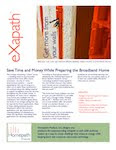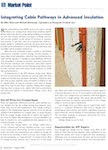To some these claims may seem outlandish, but remember how, just a few short years ago, you marveled at your first low-resolution digital camera, and the space-aged ability to save photographs electronically . . . easily sharing them with friends by way of mailed CDs.
Fiber in the Home?
In this post, we’ll explore this declaration a bit more in an attempt to clarify what it may imply. (Skip to the end for the takeaways or read on if you’re curious to understand what all is behind it.)
Everyone has a secret desire to know about photons
Not all optical fibers are created equal. And the video tells us only that the fiber has a diameter of 125µm. As with most technologies, there are many variations, but here we will discuss only the two most likely. The 125µm dimension refers to the fiber’s “cladding.” It has a name; so it must do something; right? In this case, the cladding is a layer of glass surrounding the core of the optical fiber, and enables the fiber to guide light. Having a slightly different chemical structure than the core, cladding reflects light trying to escape the core back into, and along the length of the fiber. Think of cladding as a mirror surrounding the entire length of fiber. The “core” of the fiber also plays a vital role. It’s the central region of the optical fiber where light is transmitted . . . the business-end . . . where you want to capture light, keep it, and efficiently move it along. Of the two fibers we will discuss, one has a 50 µm core, and is called multimode; the second with a very small core, roughly 8.3 µm, is referred to as singlemode. (In the interest of full disclosure please be aware that plastic optical fiber [POF] exists and could be used in this application. As more about “Light Peak” is disclosed we may expand on POF.) Above, a techno-zinger called “mode” sheepishly inserted itself within the text. It is important too. But what is a mode? Well, in optical terms, it simply means “a pathway for light”.
Stay with me here-all of this is leading up to an important takeaway . . .
To fully appreciate modes, you need to envision how fibers work. The goal is to couple light from a source directly into the core of the fiber. Within the core, you’ll find these modes, or pathways. As a light source turns on, it produces a pulse – a short duration burst of photons. Think of a “photon” as a particle of light and the pulse as a cloudburst of photons. Squeeze that into the end of the fiber, and send it on its way with all photons selecting their own “modes” to follow within the core. So, if you have a multimode fiber, a reasonable assumption is that it has multiple modes within its core. (You can imagine light bouncing along inside the fiber over its length.) There are thousands of modes within a 50µm core, each mode creating a slightly different path length from the start of the optical fiber to its end. Photons enter the fiber simultaneously — like a mass start in a mountain bike race. By traveling on modes of differing path lengths, they arrive at the other end at slightly different times, effectively stretching the pulse out over the length and enabling them to blend into one another. Referred to as modal dispersion, this is the primary limitation for data transmission in multimode fiber. Modal Dispersion limits the fiber for 10Gb/s transmission to a distance of about 1,800 feet.
If “multi” modes lead to signal spreading, and limit the speed and distance for data transmission…is it possible to improve performance by reducing the number of modes?
As the name implies, singlemode allows only a single pathway or mode. This is achieved by reducing the diameter of the core. With only one pathway, pulse spreading cannot occur … accordingly, there are no practical limits on data rate or distance with singlemode fiber. (For those living in Verizon FiOS or Telus territory…this singlemode stuff is what’s being connected to your home…so they’ve got you well covered for internet service upgrades for quite a while.) From the Intel announcement, we know the “Light Peak” solution will be incredibly fast, scalable, and capable of greater distances than practically necessary within the home. This technology may be incorporated in consumer electroncis as early as 2011.
Takeaways:
Other characteristics of optical fiber that may influence Intel’s investigation:
- Optical fiber is completely immune to the effects of radio frequency and electromagnetic interference. Not only does this support tremendous performance, it greatly simplifies cable placement . . . . Running optical fiber in parallel and proximal to line voltage wiring would not affect the data signal whatsoever.
- Decades of fiber draw and coatings process improvements, coupled with stringent proof-testing practices by manufacturers, produce optical fibers that are no longer fragile.
- Optical fibers are customarily packaged in small diameter flexible cables for easy handling.
- With no metallic components, fiber optic cables function well to isolate sensitive equipment from electrical surges.
- “Light Peak” is positioned as a likely improvement to USB technology. This raises the question of powering devices. The optical fiber itself cannot carry electrical power but a hybrid cable containing optical fiber and metallic conductors can easily be produced, providing the benefits of higher data performance, extended length, and power.
Much of Intel’s activity leans on their expertise in chip design and production
Success with the “Light Peak” project will show Intel’s design and production strengths through fast, economical, reduced-energy optical chips. Consumers will benefit as a new era of electronics is ushered in: expect generations of enhanced consumer electronics, applications to run on them, and dramatic content improvements. Reach beyond Intel and recognize the trend to dramatically increase broadband speeds through Fiber-To-The-Home (FTTH) initiatives by Verizon, AT&T, Cincinnati Bell, Telus and many municipalities. The notion of 10Gb/s data rates directly from internet service providers is technically feasible now, and may be commercially pragmatic in a few short years. What does this mean for the consumer? Better, faster, cheaper… Rather than connecting devices with a short USB cord, you may be using optical cables or some hybrid of the two. We know technology evolves quickly so when we design and build homes we must anticipate progress. And a simple change like extended distance opens opportunity for improved home design. Envision a day when optical fiber replaces Cat5e and coaxial cables within the walls . . . and take comfort knowing that new building systems like eXapath™ are now available. They integrate seamlessly during construction, complement energy conserving insulation, and prepare the structure for generations of change in consumer electronics technology.
We’ve come so far…and the journey has just begun.
Related links:
Intel's new fiber-optic cables promise speed boost - Steven Johnson - San Jose Mercury News
More on the chemistry and physics making advances like Intel's Light Peak economical: MIT: New germanium laser better for computing.
Interesting Facts about Light Peak directly from Intel: Direct link to pdf download.
Video comments from Intel: CES 2010
Paul Otellini, CEO of Intel at ”CES 2010: Amid the USB 3.0 announcements at CES, Otellini pushed Intel's faster Light Peak technology. The standard is claimed to transfer data at 10 gigabits per second, downloading an entire Blu-ray disc in 30 seconds. The CEO suggests the optical Light Peak cables will replace "all the cables in your system," such as HDMI and DVI.
CTOEdge: "Light Peak, which has backing from Sony and Nokia, is expected to start showing up in devices later this year. Given the amount of processing power available on the client these days, and the size of the files that people are trying to work with, it’s pretty clear that a bandwidth problem is on the way."
Anne Eisenberg - NYTimes - An Express Lane from Camera to Computer
Update: Nov 27, 2010 - Rumors swirling of an Apple Macbook Pro with "Light Peak" technology for April 2011







.jpg)


An update of sorts, came across a news item today (10-23-09) suggesting that the introduction of USB 3.0 may be later than expected...rumored to be delayed in favor of Intel's "Light Peak" technology...watch this space.
ReplyDeletehttp://www.techspot.com/news/36673-intel-delays-usb-30-support-until-2011.html
Great Info!!
ReplyDeleteI came across another blog posting (from @FTTxtra)that hints at the impact of "Light Peak" technology on the non-computer-peripheral elements of the network. It's well written...this may also interest you.
ReplyDeletehttp://www.fttxtra.com/home-networking/light-peak/
Great article. Keep 'em coming!
ReplyDelete- Peter G
I really enjoyed this article. Not to sound like Tim Allen, but I love 'More Power'. It am glad to see that people are beginning to think about the future of connectivity.
ReplyDeleteThanks Brian,
ReplyDeleteI like the Tim Allen reference, especially given your frequent use of the Binford 2000 hand planer at http://extremelyaverage.com/.
Thanks,
Mike